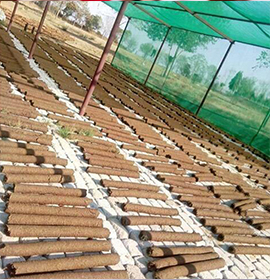
Cow dung, also known as cow pats, cow pies or cow manure, is the waste product of bovine animal species. These species include domestic cattle ("cows"), bison ("buffalo"), yak, and water buffalo. Cow dung is the undigested residue of plant matter which has passed through the animal's gut. The resultant fecal matter is rich in minerals. Color ranges from greenish to blackish, often darkening soon after exposure to air.
In lots of spiritual “yagnasâ€, the fire is burnt using dried cow dung and ghee. It is said that burning cow dung with ghee is one of the best ways to purify the home. Well scientifically, researches have found out that the cow dung purifies the air and also has anti-pollutant and anti-radiation qualities in the environment. In India, during the fire festivals, cow dung cakes are burnt to purify the atmosphere. Such festivals are Bhogi, Sankranti, Lohri, Pongal, and Bishu. Cow Dung is also used during the festivals of Naagpanchami, nuakhai, Onam, Karama, kajari, Ugadi, Gudi-padwa and Govardhan pooja festivals to invite the auspicious energies of Goddess Lakshmi into one`s life. During the Holika, cow dung is dried and made into round shaped flat balls which are used to burn the Holika up. In many parts of the developing world, and in the past in mountain regions of Europe, caked and dried cow dung is utilized as fuel. Dung may also be collected and used to produce biogas to generate electricity and heat. The gas is rich in methane and is used in rural areas of India and Pakistan and elsewhere to provide a renewable and stable source of electricity. In central Africa, Maasai villages have burned cow dung inside to repel mosquitos. In cold places, cow dung is used to line the walls of rustic houses as a cheap thermal insulator. Most of the villagers in India spray fresh cow dung mixed with water in front of the houses to repel insects. It is also dried into cake-like shapes and used as a replacement for firewood. Cow dung is also an optional ingredient in the manufacture of adobe mud brick housing depending on the availability of materials at hand.
Precautions : It is possible to transfer illness to humans by putting cow manure on vegetable beds. Minimize the risk of infection by allowing the manure to age in the soil for about six months before planting anything edible in the soil, and never apply fresh manure after vegetables have been planted. Fresh manure also should not be applied to ornamental plants because its high nitrogen content can burn plant tissue, result in plants that are more attractive than usual to pests and add live weed seeds to the garden.
